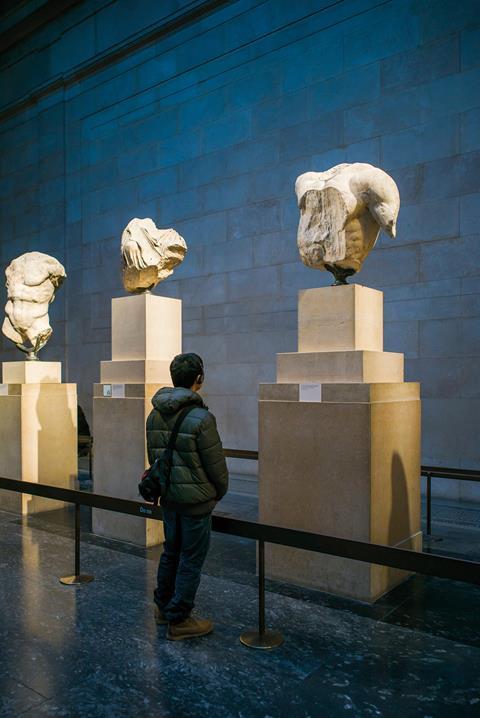The Parthenon Marbles Dispute
Alexander Herman
£17.99, Hart
★★★★✩
Many museums have been dealing with legal and moral claims for the return of part of their collections. These include artworks allegedly looted by the Nazis which at some point entered the antiques market and were later acquired by institutions. There have been requests about items of special religious or cultural significance which it is argued should not be held in a museum. This book, which is the first in a series entitled The Art Law library, was written by Alexander Herman, the director of the Institute of Art and Law. It reviews and discussed the cases for the return or retention of the Elgin Marbles or, the British Museum’s preferred term, the 'Parthenon sculptures' (pictured).

The Elgin Marbles are a collection of ancient Greek sculptures which were removed from the Parthenon in Athens and transported to England by Thomas Bruce, 7th Lord Elgin, who was British ambassador to the Ottoman Empire (1799–1803). They are undisputedly works of great cultural and artistic value and European heritage. In the early nineteenth century when Lord Elgin was ambassador, Greece was occupied by the Ottoman Empire. He argued that he obtained legal written permission from the Turkish authorities to remove the sculpture, An Italian translation of that document exists, but not the original, and the meaning of the wording has been disputed. Was it indeed valid, what 'stones' could be removed and if so where would they go and was the agreement void because of corruption?
Lord Elgin was a classical art enthusiast and was not collecting on behalf of the British government. One of the ships carrying some sculptures was sunk but the cargo was recovered. His actions in taking them were challenged at the time and the matter was the subject of a Parliamentary Select Committee inquiry in 1816. It found they were legitimately acquired, and parliament debated it and then voted the funds needed for the British Museum to acquire them later that year. According to one writer the issue of the sculptures was settled, 'by two of the most authoritative tribunals known to the constitution of this country.' They are now held under the terms of the British Museum Act 1963 which restricts sale of items from the collection.
Interestingly not long after this, Britain was involved in restitution art works looted by Napoleon’s armies in the wars leading up to 1815. The French government had a policy of 'centralising' art in Paris and with the peace came pressure to return the items.
Elgin sold them to this country as he was short of cash following an expensive divorce, amongst other problems. He had turned down an offer from Napoleon for the sculptures. Elgin had argued that if he had not taken them, then the French might have done so or they would have been lost or destroyed because of the Turkish lack of interest in them.
There was a request for their return after Greece gained independence in 1821 and a suggestion was made in Britain for their return after the Second World War in gratitude for resisting the Nazis. In October 1983, following support at UNESCO the previous year, the Greek government made a formal request to the UK government for their return. The request was formally rejected by the UK in April 1984.
There have been various attempts at compromise including returning some but not all and offering a loan of them not a handover of ownership. At one point, quite recently and bizarrely, one of the Elgin Marbles statues was on loan to Putin’s Russia.
The UK government’s policy is that '…Issues relating to the ownership and management of the Parthenon sculptures are matters for the trustees of the British Museum.' The Museum has pointed out it is not a government body, and the collections do not belong to the British government. 'The Trustees of the British Museum hold them not only for the British people, but for the benefit of the world public, present and future. The Trustees have a legal and moral responsibility to preserve and maintain all the collections in their care, to treat them as inalienable and to make them accessible to world audiences.'
There has been much media interest in the story over the years and celebrity campaigns starting with Lord Byron who had witnessed some of the marbles being removed. He called Lord Elgin '…The last, the worst, dull spoiler.'
The legal aspects of the matter are interesting, ranging from the law of sale of goods including whether an honest purchaser without notice, can obtain title and also the presumption that comes from having possession of goods, the law of limitation, international law and questions of jurisdiction. If the issue was ever to be resolved by a court how this would be done?
What the book does not reflect on at any length is if the marbles are returned then how that precedent effect other items in the museum’s collection and other similar institutions. Museums are still tackling issues of Nazi spoliation, illegally sold or imported artefacts and non-reported finds of treasure. It is an interesting legal issue and this book highlights many lesser known facts.
David Pickup is a partner at Pickup & Scott Solicitors, Aylesbury































No comments yet